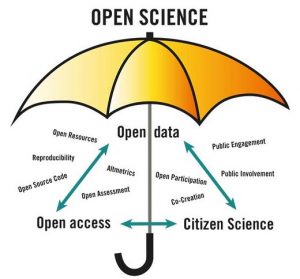Mar
26

Posted in: #CC/Academic List, All Members, Data Science
Tags: open data, open science
 Reflecting on the immense amount of data openly and freely available online, especially on COVID-19, I wanted to write a blog post about the value and opportunities available to researchers related to open data. But as I began to write I thought about the other aspects of ‘openeness’ and realized there is so much more to write about than just open data. A recent blog post published by the SEA region of NNLM during love data week, 23 things about open data, completely covers the open data piece and I have nothing to add there. In addition, you may want to check out the very comprehensive list of COVID-19 open-access data and computational resources compiled by the Office of Data Science Strategy.
Reflecting on the immense amount of data openly and freely available online, especially on COVID-19, I wanted to write a blog post about the value and opportunities available to researchers related to open data. But as I began to write I thought about the other aspects of ‘openeness’ and realized there is so much more to write about than just open data. A recent blog post published by the SEA region of NNLM during love data week, 23 things about open data, completely covers the open data piece and I have nothing to add there. In addition, you may want to check out the very comprehensive list of COVID-19 open-access data and computational resources compiled by the Office of Data Science Strategy.
However, I think there are other aspects of open science at a broader level that could use some additional explanation and examples. The Carpentries, a non-profit organization, provides open and free coding and data science training opportunities through three programs, Data Carpentry, Software Carpentry, and Library Carpentry. Their lessons are all available online for self-directed learning or you can participate in training opportunities near you. Open Science can also entail open and participatory data collection through citizen science research activities like SciStarter. Open science initiatives and scientists often rely on open-source software and tools such as Zotero for collaborating on citation collection, Open Refine, Phyton, and R studio for data collection and manipulation, as well as many other visualization and data applications so that data can be easily shared and manipulated. Open Science also entails open collaboration for doing research that integrates tools for storing and sharing open science projects through the full research cycle such as the Open Science Framework (OSF). Open repositories can provide an infrastructure and space for collecting, archiving and preserving open data and provide identifiers for data collections when the research is finally published. And last but not least, is the emerging number of opportunities for publishing open research such as journals and books. Although many publishers require the author to pay publications fees for making research open to other researchers, there are many quality and open research examples available.
Even as I have been research open science and open scholarship I have found some open textbooks about open science I would like to recommend such as the Open Data Handbook, Open: The Philosophy and Practices that are Revolutionizing Education and Science, Issues in Open Research Data, and international perspectives in the Social Dynamics of Open Data. The Foster Open Science website in the EU offers some interesting paths into open science based on what you are interested in doing So to get started, jump into the open culture at any of these different open points to learn more about open data, how to find and manipulate open data, and how to share and publish in open formats.
Open Sicence Umbrella Image: Flicker